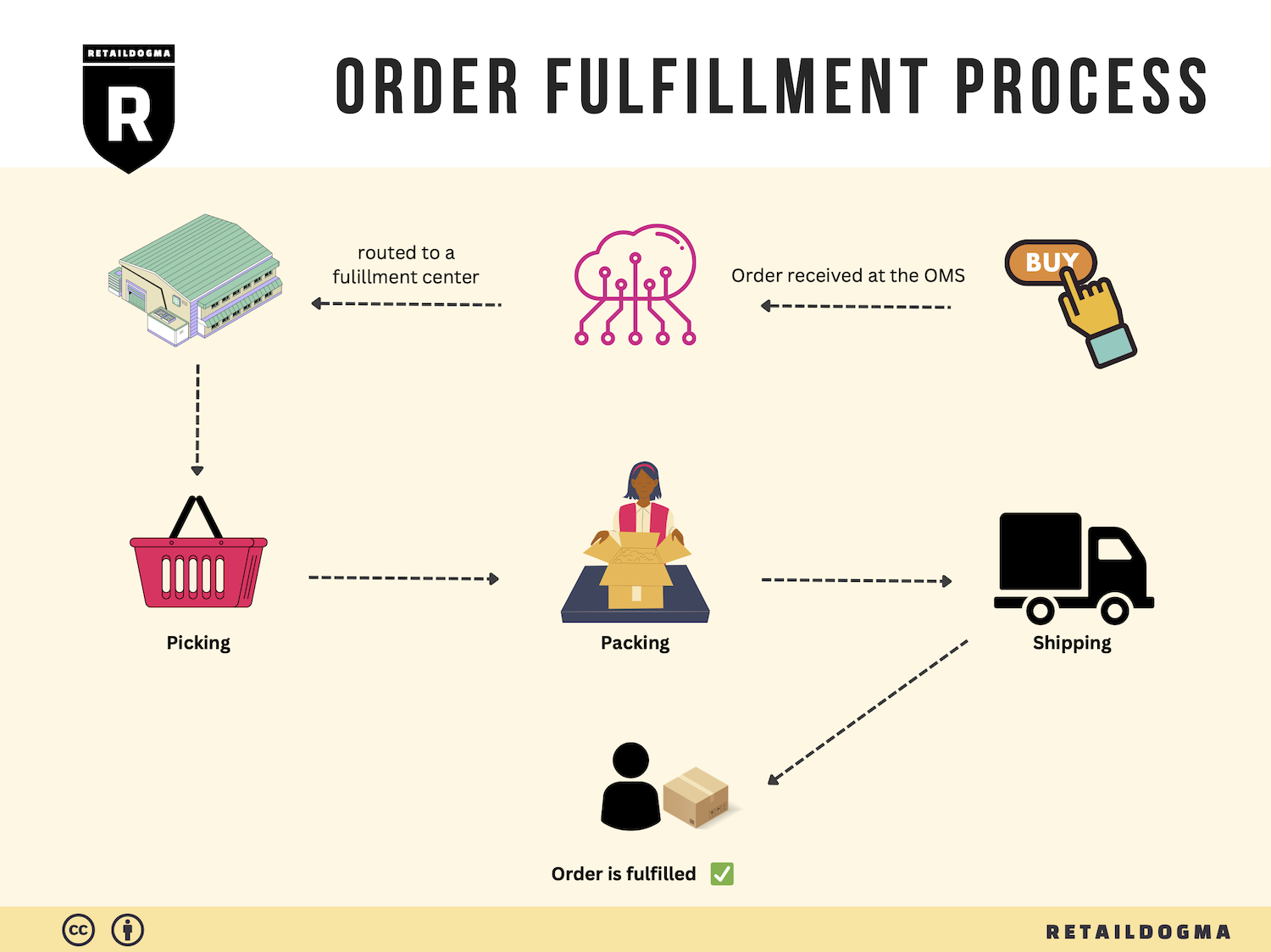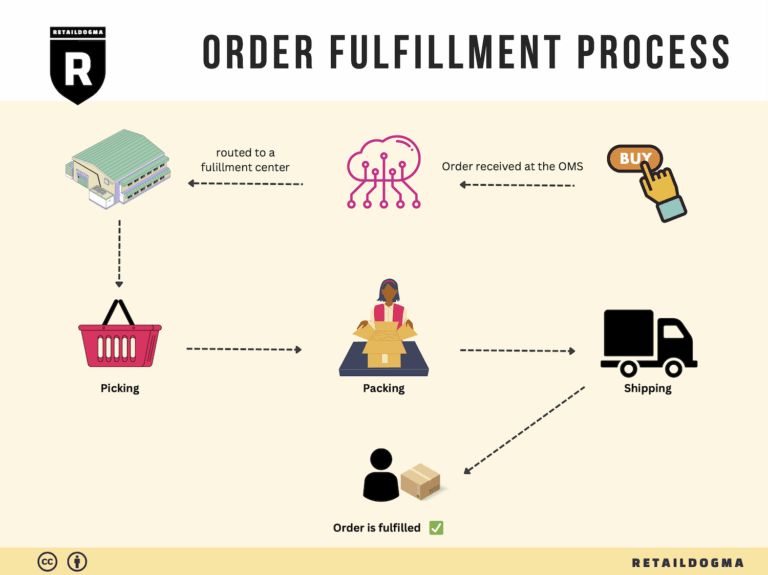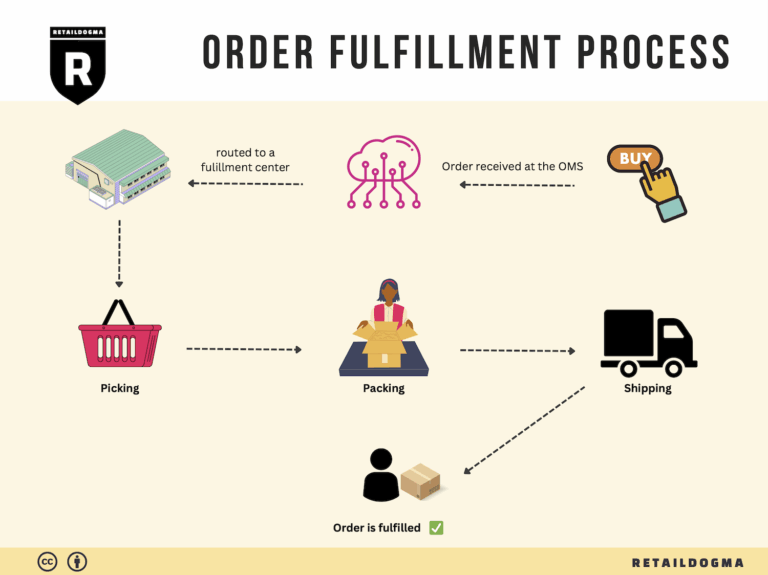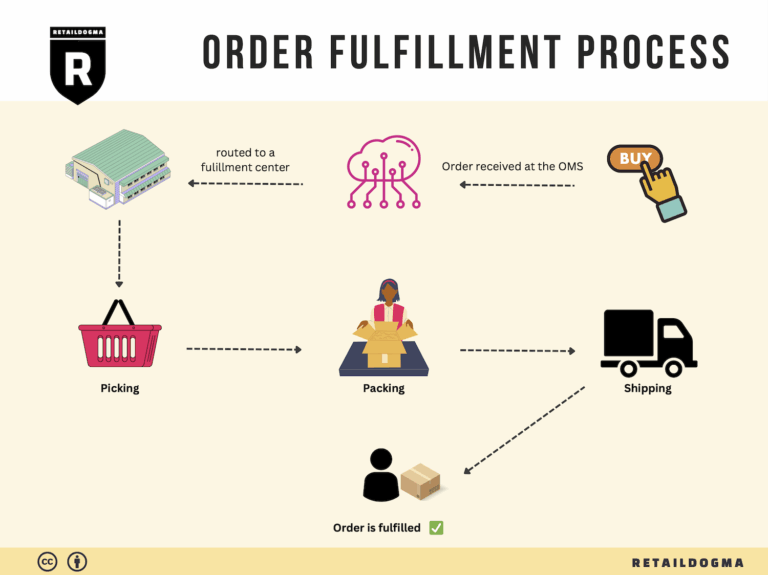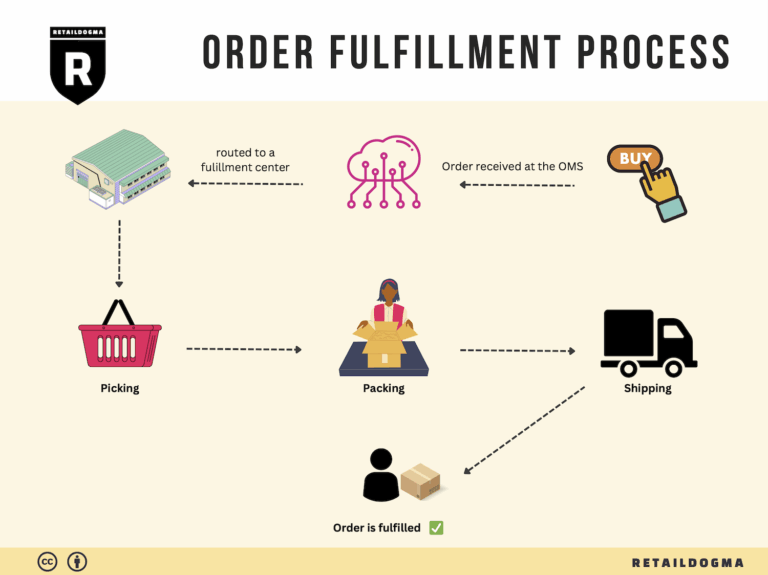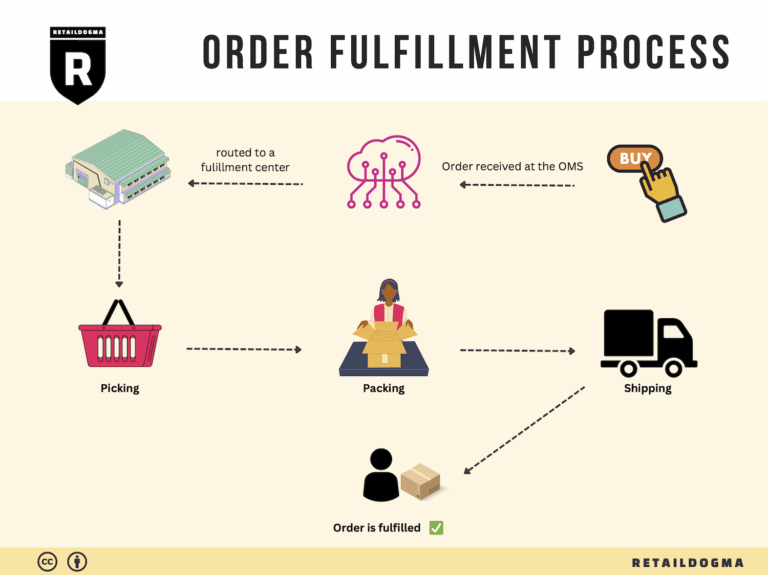What Is A Fulfillment Center? A Complete Guide (2025)
What is E-commerce Fulfillment? An Introduction for Growing Businesses
Understanding E-commerce Fulfillment: A Key to Scaling Your Business
As an e-commerce business owner, you know the thrill of making sales, but with growth comes the inevitable challenge of managing packing and shipping orders. The process of getting a product from your warehouse to your customer’s doorstep can quickly become overwhelming. Without a streamlined approach to fulfillment, your operational efficiency may suffer, leading to delays, increased costs, and dissatisfied customers. This is where understanding e-commerce fulfillment becomes essential.
At its core, fulfillment is the process of receiving, processing, and delivering orders to customers. It encompasses everything from inventory management to picking, packing, and shipping. When done effectively, fulfillment can enhance customer satisfaction, improve operational efficiency, and ultimately drive sales growth.
In this guide, we will explore the various fulfillment models available to e-commerce businesses, including Third-Party Logistics (3PL) and Fulfillment by Amazon (FBA). Each model has its advantages and considerations, and the right choice depends on your business’s specific needs and growth trajectory.
We will also delve into the core services that are integral to fulfillment operations. These include inventory management, order processing, packing, shipping, and returns management. Understanding these services will help you identify areas where you may need assistance or improvement.
Choosing the right fulfillment partner is crucial for scaling your operations. We will provide practical tips on what to look for in a fulfillment provider, including their technology capabilities, shipping options, customer service, and scalability. A strong partnership can make a significant difference in your ability to meet customer expectations and grow your business efficiently.
Finally, we will address pricing structures for fulfillment services. Understanding the cost implications of different fulfillment options will enable you to make informed decisions that align with your budget and growth goals.
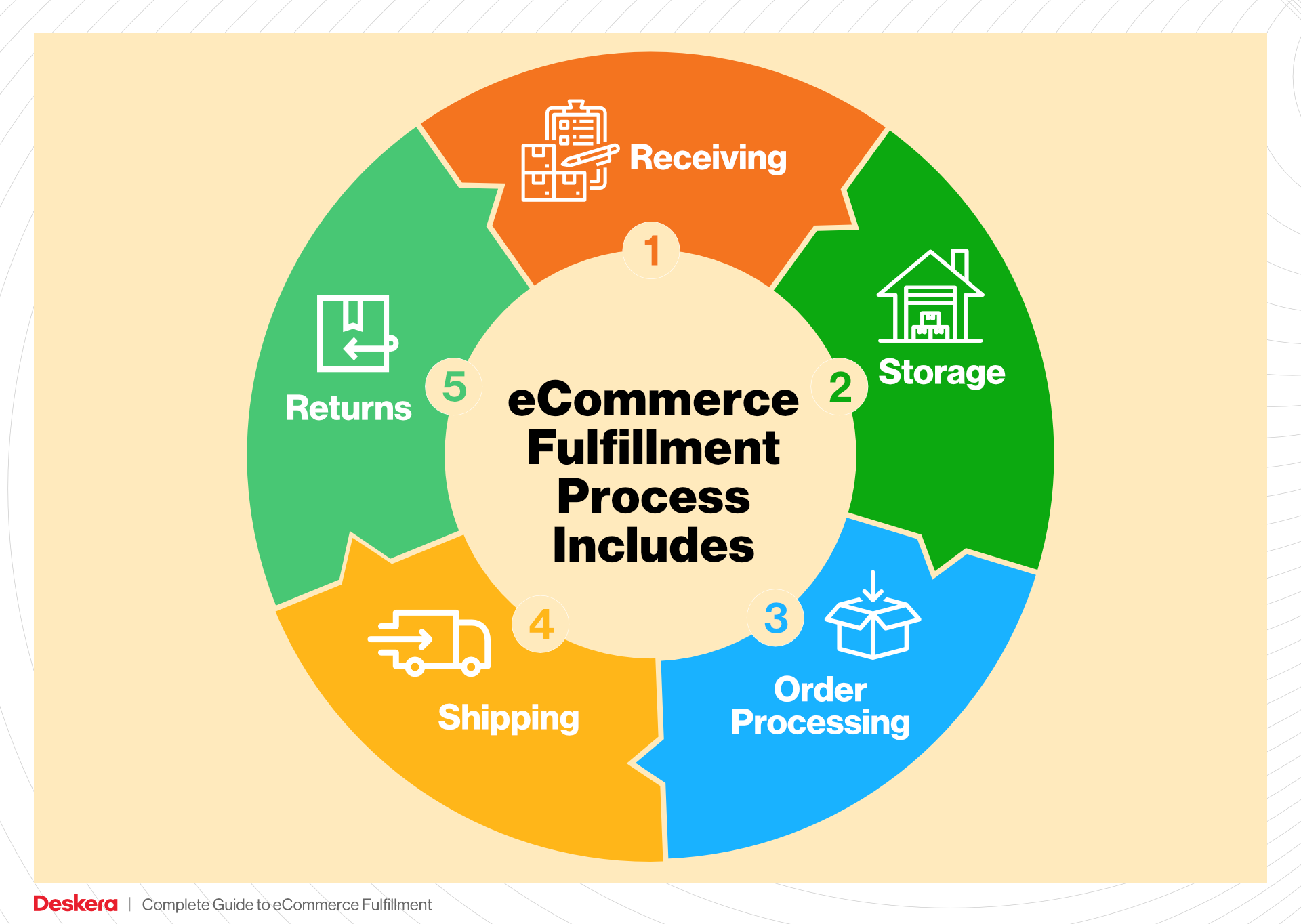
The goal of this guide is to empower you with the knowledge and tools necessary to make smart decisions about your logistics. With the right fulfillment strategy in place, you can focus on what you do best—growing your business and delighting your customers. Let’s embark on this journey to streamline your fulfillment process and elevate your e-commerce operations.
What You’ll Learn In This Guide
- What is E-commerce Fulfillment? An Introduction for Growing Businesses
- The Order Fulfillment Process: From ‘Buy’ Button to Customer’s Door
- Comparing Fulfillment Models: In-House vs. 3PL vs. Dropshipping
- A Deep Dive into Amazon FBA: Pros, Cons, and Who It’s For
- Core Services Offered by Fulfillment Centers
- How to Choose a Fulfillment Partner: A 6-Point Checklist
- Understanding Fulfillment Pricing: A Breakdown of Common Fees
- Frequently Asked Questions (FAQs) about Fulfillment
- Conclusion: Is Outsourcing Fulfillment the Right Move for Your Business?
- Important Disclaimer
The Order Fulfillment Process: From ‘Buy’ Button to Customer’s Door
1. Receiving Inventory
The order fulfillment process begins with receiving inventory, which is a crucial step for any e-commerce operation. During this phase, products are delivered to the warehouse from suppliers or manufacturers. It’s essential to inspect these shipments for accuracy and quality, ensuring that the received items match the purchase orders.
Key tasks include checking the quantity of items against the shipping documents, inspecting for damage, and verifying that the correct items have been delivered. This process is critical because discrepancies can lead to stockouts or excess inventory, which can impact customer satisfaction and cash flow.
A key term associated with this step is SKU (Stock Keeping Unit). Each product should have a unique SKU to facilitate tracking and management. By utilizing SKUs, businesses can streamline the receiving process, ensuring that inventory levels are updated accurately in the system.
2. Warehouse Storage
Once the inventory is received and verified, it needs to be stored properly in the warehouse. This step involves determining the optimal location for each product, which can significantly affect the efficiency of the picking process later on.
Efficient warehouse storage is vital because it maximizes space utilization and minimizes the time taken to retrieve items when orders come in. Products can be stored in various ways, such as by category, size, or demand frequency. For example, fast-moving items may be placed closer to the packing area to expedite order fulfillment.
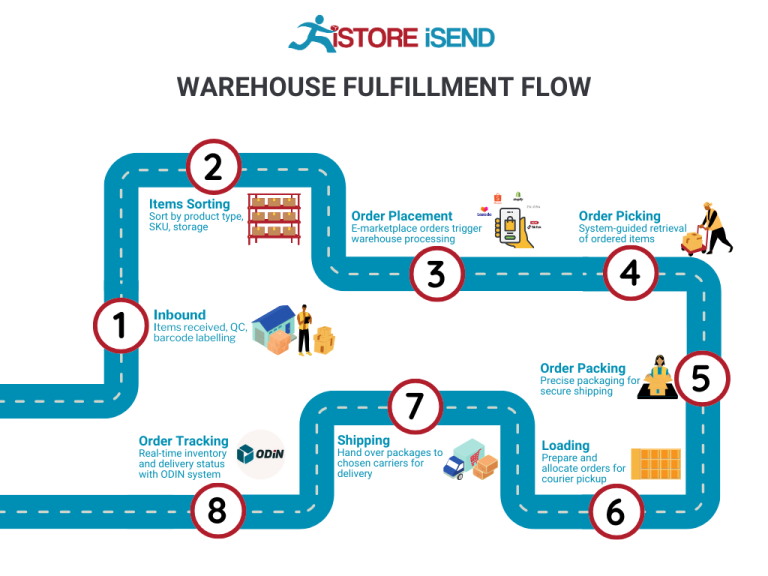
A critical term in this step is ABC Analysis, which categorizes inventory based on its value and turnover rate. By implementing ABC Analysis, e-commerce businesses can prioritize storage locations for high-value items, thus improving overall efficiency.
3. Order Picking
Order picking is the process of retrieving items from the warehouse to fulfill customer orders. This step is pivotal because the accuracy and speed of picking directly influence customer satisfaction. Efficient picking processes reduce the likelihood of errors, such as sending the wrong item or quantity, which can lead to returns and dissatisfaction.
There are various picking methods, including single-order picking, batch picking, and zone picking. The choice of method often depends on the volume of orders and the complexity of the inventory. For instance, batch picking can be more efficient when processing multiple orders that contain similar items.
A key term in this phase is pick lists. These are generated documents that guide pickers on which items to retrieve and their locations within the warehouse. Utilizing pick lists helps ensure that orders are filled accurately and efficiently, ultimately enhancing the customer experience.
4. Order Packing
After items are picked, the next step is order packing. This involves securely packaging the products to prevent damage during transit while also ensuring that the packaging is efficient in terms of size and cost. Proper packing is crucial because it not only protects the items but also contributes to the overall unboxing experience for customers.
During the packing process, it’s essential to include any necessary documentation, such as packing slips or invoices, and to select appropriate shipping materials, like boxes or padded envelopes. Businesses should also consider branding elements in packaging to enhance customer perception and loyalty.
A vital term in this context is dimensional weight pricing. Many carriers use this pricing model, which considers the size of the package rather than just its weight. Understanding this concept can help e-commerce businesses optimize their packaging strategies to reduce shipping costs.
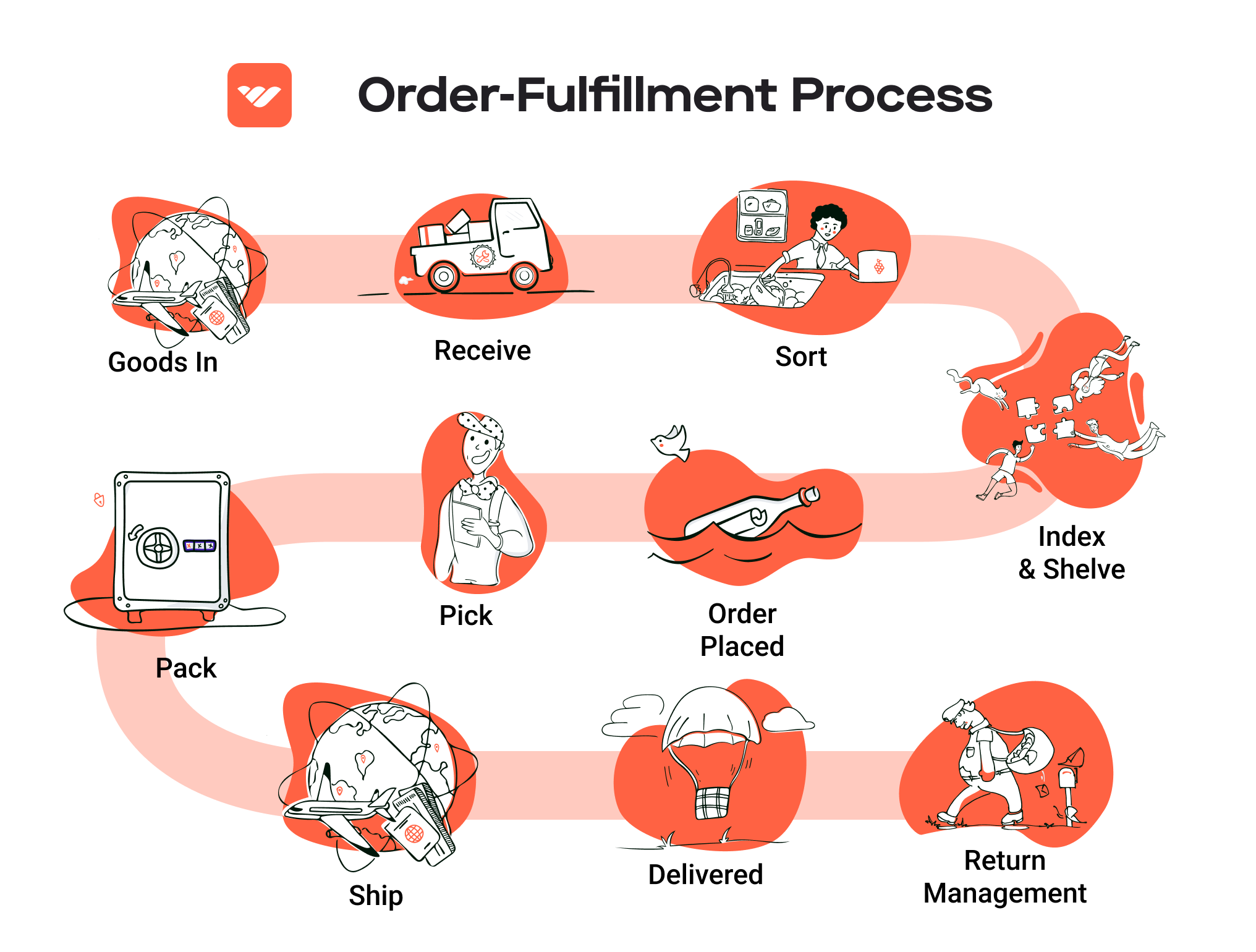
5. Shipping & Delivery
The final step in the order fulfillment process is shipping and delivery. Once packages are packed, they are handed over to shipping carriers for delivery to the customer. Timely and accurate delivery is a critical factor in customer satisfaction and can significantly influence repeat purchases.
Businesses must choose the right shipping methods based on factors like cost, speed, and customer preferences. Options may include standard shipping, express shipping, or even same-day delivery in some markets. It’s important to provide customers with tracking information so they can monitor their orders.
A key term associated with this step is last-mile delivery. This refers to the final leg of the delivery journey, where the package is transported from a distribution center to the customer’s door. Effective last-mile delivery strategies can improve customer satisfaction and reduce shipping costs, making it a vital area for e-commerce businesses to focus on as they scale.
By understanding and optimizing each step of the order fulfillment process, e-commerce businesses can significantly enhance their operational efficiency, improve customer satisfaction, and drive growth.
Comparing Fulfillment Models: In-House vs. 3PL vs. Dropshipping
Fulfillment Model Comparison
| Model | Who Handles Inventory | Best For (Business Stage) | Key Advantage | Key Disadvantage |
|---|---|---|---|---|
| In-House Fulfillment | The e-commerce business | Startups to Medium-Sized | Full control over inventory and processes | Higher operational costs and complexity |
| Third-Party Logistics (3PL) | 3PL provider | Growth to Established | Scalability and reduced overhead | Less control over inventory and processes |
| Dropshipping | Supplier or Manufacturer | Startups and Small Businesses | Low upfront investment and risk | Lower profit margins and supplier dependency |
In-House Fulfillment
In-house fulfillment refers to the process where an e-commerce business manages its own inventory, storage, and shipping operations. This model is particularly well-suited for startups and medium-sized businesses that want to maintain full control over their supply chain. One of the significant advantages of in-house fulfillment is the ability to oversee every aspect of the logistics process, from inventory management to order fulfillment. This control can lead to enhanced customer service and quicker response times, as businesses can directly manage their stock levels and shipping schedules.
However, running an in-house fulfillment operation can also come with considerable challenges. The need for warehousing space, staffing, and technology to manage logistics can result in higher operational costs. As businesses scale, they may find it increasingly complex to maintain efficiency and service levels, leading to potential bottlenecks in the fulfillment process. Furthermore, the demand for warehousing and logistics expertise may stretch the business’s resources, especially if it lacks experience in this area.
Third-Party Logistics (3PL)
Third-party logistics (3PL) involves outsourcing the logistics operations to a specialized provider. This model is ideal for businesses that are in the growth phase or those that have already established a solid market presence. By partnering with a 3PL provider, businesses can benefit from a scalable fulfillment solution that allows them to focus on core activities like marketing and sales while leaving the logistics to experts.
One of the primary advantages of 3PL is the ability to reduce operational overhead. Businesses can avoid the costs associated with maintaining their own warehousing, staff, and logistics technology. Additionally, 3PL providers often have established relationships with carriers, which can lead to better shipping rates and faster delivery times. However, a key disadvantage is the reduced control over inventory management and fulfillment processes. When relying on an external provider, businesses must trust that the 3PL will meet their service standards, which can sometimes lead to discrepancies in customer service and fulfillment accuracy.
Dropshipping
Dropshipping is a fulfillment model where the e-commerce retailer does not keep products in stock. Instead, when a customer places an order, the retailer purchases the item from a third party—usually a manufacturer or wholesaler—who then ships it directly to the customer. This model is particularly advantageous for startups and small businesses looking to minimize risk and financial investment in inventory.
The primary benefit of dropshipping is the low upfront investment required. Since businesses do not need to purchase inventory upfront or manage a warehouse, they can allocate resources to other areas, such as marketing and customer acquisition. This flexibility allows new businesses to test various products and markets without significant financial commitments. However, dropshipping also presents challenges. The profit margins tend to be lower than other fulfillment models, as retailers often have to pay a premium for the convenience of not holding inventory. Moreover, reliance on suppliers can lead to issues with inventory availability and shipping delays, which can negatively impact customer satisfaction and brand reputation.
Conclusion
When selecting a fulfillment model, e-commerce business owners must carefully consider their current operational capabilities, growth ambitions, and customer service expectations. In-house fulfillment offers control and potential for personalized service, but at the cost of higher operational complexities. Third-party logistics provide scalability and reduced overhead, but may sacrifice some control over the fulfillment process. Dropshipping allows for a low-risk entry into e-commerce, though it often comes with lower profit margins and potential reliability issues. Understanding the nuances of each model is crucial for making an informed decision that aligns with the business’s long-term goals.
A Deep Dive into Amazon FBA: Pros, Cons, and Who It’s For
Understanding Fulfillment by Amazon (FBA)
Fulfillment by Amazon (FBA) is a service provided by Amazon that allows sellers to store their products in Amazon’s fulfillment centers. Amazon takes care of storage, packaging, and shipping, enabling sellers to focus on other aspects of their business. When a customer places an order, Amazon handles the entire process, from order fulfillment to customer service, including returns.
This model allows sellers to leverage Amazon’s extensive logistics network and customer trust, making it an attractive option for many e-commerce businesses. Here’s a closer look at how FBA works:
-
Product Listing: Sellers create product listings on Amazon and indicate that they want to use FBA. They prepare their products according to Amazon’s guidelines and ship them to Amazon’s fulfillment centers.
-
Storage: Once the products arrive at the fulfillment center, Amazon stores them until they are sold. Sellers are charged storage fees based on the space their inventory occupies.
-
Order Fulfillment: When a customer orders a product, Amazon picks, packs, and ships it on behalf of the seller. This process is streamlined to ensure quick delivery, often eligible for Amazon Prime shipping.
-
Customer Service: Amazon manages all customer service inquiries related to FBA orders, including handling returns and refunds. This service allows sellers to maintain a high level of customer satisfaction without the burden of direct customer support.
-
Multi-Channel Fulfillment: Sellers can also use FBA to fulfill orders from other sales channels, not just Amazon. This allows for a unified inventory management system.
Pros of Using FBA
1. Prime Eligibility
One of the most significant advantages of FBA is that it allows sellers to offer their products with Amazon Prime eligibility. This feature can significantly increase sales, as Prime members often prefer products that can be shipped quickly and for free.
2. Customer Trust
Amazon has built a reputation for reliability and customer service. By using FBA, sellers can leverage this trust, as customers often feel more secure purchasing items that are fulfilled by Amazon. This can lead to higher conversion rates and customer loyalty.
3. Scalability
FBA allows businesses to scale quickly without the need to invest heavily in logistics. As a seller’s sales increase, they can send more inventory to Amazon’s fulfillment centers without worrying about how to manage storage and shipping themselves.
4. Multi-Channel Fulfillment
Sellers can use FBA to fulfill orders from various platforms, not just Amazon. This means they can centralize their inventory management and streamline operations, allowing for more efficient handling of orders from different sales channels.
5. Simplified Logistics
FBA simplifies logistics for sellers, as Amazon handles the warehousing, packing, and shipping processes. This can save significant time and resources, allowing sellers to focus on marketing and product development instead.
Cons of Using FBA
1. High Fees
While FBA provides many advantages, it also comes with costs. Sellers must pay storage fees for their inventory and fulfillment fees for each order shipped. These fees can quickly add up, particularly for sellers with lower profit margins.
2. Strict Inventory Rules
Amazon has strict inventory management guidelines that sellers must adhere to. This includes limits on the number of units that can be stored in fulfillment centers and requirements for labeling and packaging. Non-compliance can result in additional fees or the return of inventory.
3. Commingling Risks
FBA products may be commingled with inventory from other sellers. While this can streamline the fulfillment process, it poses a risk if a customer returns a defective item or if there are quality control issues. Sellers may receive returns that do not belong to them, complicating the returns process.
4. Loss of Control
Using FBA means relinquishing some control over the fulfillment process. Sellers must rely on Amazon to handle their products, which can lead to concerns about inventory management, packaging quality, and shipping times.
5. Dependency on Amazon
Relying on Amazon for fulfillment can create dependency, making it challenging for sellers to pivot to other fulfillment options if needed. Changes in Amazon’s policies or fees can significantly impact a seller’s bottom line.
Who is FBA Best For?
Fulfillment by Amazon is ideally suited for:
-
Small to Medium-Sized Businesses: Companies looking to scale without the burden of managing logistics can benefit greatly from FBA. It allows them to focus on marketing and sales while Amazon handles the fulfillment process.
-
E-commerce Entrepreneurs: New sellers who want to enter the Amazon marketplace can leverage FBA to quickly establish a presence and gain access to Prime customers.
-
Brands with High Sales Volume: Businesses that have established brands and a high volume of sales can take advantage of FBA’s logistics capabilities to efficiently manage their inventory.
-
Sellers with Diverse Product Lines: Those selling multiple products across various categories can benefit from the streamlined logistics and inventory management provided by FBA.
-
Businesses Seeking Expansion: Companies looking to expand their reach into new markets can use FBA to facilitate international shipping and fulfillment without significant investment in infrastructure.
In conclusion, while Fulfillment by Amazon offers numerous benefits, including increased sales potential and simplified logistics, it is essential for businesses to weigh these against the costs and challenges associated with the program. By understanding the pros and cons, e-commerce entrepreneurs can make informed decisions about whether FBA is the right fit for their business model.
Core Services Offered by Fulfillment Centers
Inventory Management & Warehousing
Inventory management and warehousing are foundational services provided by fulfillment centers. This service entails the systematic oversight of stock levels, storage, and replenishment. Fulfillment centers utilize advanced inventory management systems that integrate with e-commerce platforms, allowing real-time tracking of inventory levels. This ensures that businesses can maintain optimal stock levels, reduce the risk of overstocking or stockouts, and make informed purchasing decisions.
Benefits:
1. Efficiency: By centralizing inventory management, businesses can streamline their operations and reduce the labor required to track and manage stock.
2. Cost Savings: Efficient inventory management minimizes excess inventory costs and storage fees, as well as reduces the risk of lost sales due to stockouts.
3. Data Insights: Access to real-time data enables businesses to analyze sales trends, forecast demand, and make strategic decisions based on accurate inventory levels.
Pick and Pack Services
Pick and pack services involve the process of selecting ordered items from inventory and packaging them for shipment. Fulfillment centers employ trained staff and sophisticated technology to ensure accuracy and speed in this process. Orders are received electronically, and the fulfillment center picks the items from the warehouse, packs them securely, and labels them for shipping.
Benefits:
1. Speed and Accuracy: Fulfillment centers leverage technology like barcode scanning and automated picking systems to enhance the speed and accuracy of order fulfillment, leading to higher customer satisfaction.
2. Scalability: As e-commerce businesses grow, their order volumes can fluctuate significantly. Fulfillment centers can easily scale pick and pack services up or down, allowing businesses to adapt to changing demands without the burden of maintaining excess staff or infrastructure.
3. Professional Packaging: Utilizing professional packing materials and techniques ensures that products are shipped securely, reducing the likelihood of damage during transit and enhancing the unboxing experience for customers.
Kitting and Assembly
Kitting and assembly services involve the grouping of individual items into a single package or kit, often tailored for specific promotions or customer requirements. This service is especially beneficial for businesses that sell products that need to be bundled together or require assembly before they are shipped.
Benefits:
1. Customization: Kitting allows businesses to offer customized products or packages, enhancing the value proposition for customers. This can lead to increased sales, as customers are often attracted to unique offerings.
2. Time Savings: By outsourcing kitting and assembly to fulfillment centers, businesses can free up internal resources and focus on core activities such as marketing and product development.
3. Inventory Optimization: Kitting can help optimize inventory levels by combining slow-moving products with high-demand items, thus increasing the overall turnover of stock.
Returns Management (Reverse Logistics)
Returns management, often referred to as reverse logistics, is a critical service offered by fulfillment centers. This process involves handling product returns from customers, assessing the condition of returned items, restocking them, or processing them for resale or disposal. Efficient returns management is essential for maintaining customer satisfaction and loyalty.
Benefits:
1. Customer Satisfaction: A streamlined returns process enhances the customer experience, as it provides a hassle-free way for customers to return products. This can lead to repeat business and positive word-of-mouth referrals.
2. Cost Efficiency: Fulfillment centers can manage returns more cost-effectively than individual businesses, thanks to their established processes and expertise. This includes evaluating returned items to determine whether they can be restocked or need to be sent for repairs or recycling.
3. Data Analysis: Analyzing return data can provide valuable insights into product quality, customer preferences, and potential areas for improvement in product offerings or marketing strategies.
Conclusion
In conclusion, partnering with a fulfillment center can provide e-commerce businesses with a suite of essential services designed to enhance operational efficiency, reduce costs, and improve customer satisfaction. By leveraging services such as inventory management, pick and pack, kitting, and returns management, businesses can scale effectively and focus on growth strategies while ensuring a seamless logistics operation. This strategic partnership can ultimately be a game-changer in a competitive e-commerce landscape.
How to Choose a Fulfillment Partner: A 6-Point Checklist
Location & Warehouse Network
The geographical location of your fulfillment partner’s warehouses is critical for efficient shipping and delivery. A strategically placed warehouse network can significantly reduce shipping times and costs, enhancing customer satisfaction.
Why It Matters:
A partner with warehouses located near your target markets can expedite deliveries, minimize shipping costs, and improve service levels. Conversely, a poorly located partner may lead to longer transit times and dissatisfied customers.
Questions to Ask:
1. Where are your warehouses located, and how do they align with my target customer base?
2. What is your average shipping time to major cities or regions I serve?
3. Can you accommodate international shipping, and if so, how does your network support this?
Technology & Integrations
The technology stack used by your fulfillment partner can make or break your operational efficiency. A partner that offers advanced technology solutions can streamline processes and enhance visibility across your supply chain.
Why It Matters:
Effective technology integrations allow for real-time tracking, inventory management, and order processing. This is vital for maintaining accurate stock levels and ensuring timely deliveries.
Questions to Ask:
1. What fulfillment software do you use, and how does it integrate with my e-commerce platform?
2. Do you provide real-time tracking for shipments, and can I access this data?
3. How do you manage inventory updates, and how frequently is data synced?
Specializations (e.g., Cold Storage, Oversized Items)
Not all fulfillment partners are created equal; some have specific specializations that may be essential for your product type. Whether you deal with perishable goods, oversized items, or fragile products, finding a partner that specializes in your niche can be a game-changer.
Why It Matters:
A partner with the right specialization will have the necessary infrastructure, knowledge, and experience to handle your products safely and efficiently, reducing the risk of damage or spoilage.
Questions to Ask:
1. Do you have experience handling products similar to mine? If so, can you provide case studies or references?
2. What specialized equipment or facilities do you have (e.g., cold storage, handling for fragile items)?
3. How do you ensure compliance with industry regulations related to my product type?
Scalability & Capacity
As your business grows, your fulfillment needs will evolve. It’s essential to partner with a 3PL that can scale operations in line with your growth trajectory.
Why It Matters:
A scalable fulfillment partner can accommodate fluctuations in order volume, seasonal peaks, and long-term growth without compromising service quality. This flexibility can save you time and money in the long run.
Questions to Ask:
1. What is your current capacity, and how do you handle peak seasons or unexpected surges in order volume?
2. Can you provide examples of how you have scaled operations for other clients?
3. What limitations might I face if my business grows rapidly, and how can you help mitigate those?
Pricing and Contracts
Understanding the pricing structure and contract terms of your fulfillment partner is crucial for maintaining profitability. Hidden fees can quickly erode margins, so transparency is key.
Why It Matters:
Clear and predictable pricing allows you to calculate costs accurately and plan your budget effectively. Additionally, understanding contract terms helps avoid unpleasant surprises later on.
Questions to Ask:
1. Can you provide a detailed breakdown of your pricing model, including any potential hidden fees?
2. What are the contract terms, and is there flexibility for renegotiation as my business evolves?
3. Do you offer volume discounts or incentives for long-term commitments?
Customer Support & Reviews
Exceptional customer service can significantly enhance your fulfillment experience. A partner that prioritizes support can help resolve issues quickly, minimizing disruptions to your business.
Why It Matters:
A responsive customer support team ensures that you can address challenges as they arise, maintaining smooth operations. Additionally, reviews and testimonials can provide insight into the partner’s reliability and service quality.
Questions to Ask:
1. What customer support options do you offer (e.g., phone, email, live chat), and what are your response times?
2. Can you share customer testimonials or case studies that highlight your service quality?
3. How do you handle disputes or issues that may arise during the fulfillment process?
Conclusion
Choosing the right fulfillment partner is a pivotal decision that can impact your e-commerce business’s efficiency and growth. By evaluating potential partners against this checklist, you can make informed decisions that align with your operational needs and customer expectations. Remember, the right partner will not only enhance your logistics but also contribute to your overall business success.
Understanding Fulfillment Pricing: A Breakdown of Common Fees
Initial Setup Fees
Initial setup fees are typically charged by fulfillment centers to cover the costs associated with onboarding a new client. These fees can vary widely depending on the complexity of the services required and the specific needs of the e-commerce business. Generally, they encompass the following elements:
- Account Creation: This includes setting up the necessary software systems to manage inventory, orders, and shipping.
- Integration Costs: If your e-commerce platform requires integration with the fulfillment center’s software, this may incur additional fees.
- Training: Some fulfillment centers charge for the training provided to your team on how to use their systems effectively.
These fees are usually a one-time expense, but it’s important to understand all components included in the setup process to avoid unexpected costs.
Receiving Fees
Receiving fees are charged when the fulfillment center receives your inventory. This fee covers the labor and resources required to unload, inspect, and store your products. The calculation of receiving fees can include:
- Per Pallet/Box Fee: Many fulfillment centers charge a fee for each pallet or box of goods received. This fee can vary based on the size and weight of the items.
- Inspection Fees: If your products require quality control checks upon arrival, additional fees may apply.
- Labeling Fees: If your products need to be labeled before storage, some centers charge for this service as well.
Understanding how receiving fees are structured can help you plan your inventory shipments more effectively.
Storage Fees (per pallet/bin)
Storage fees are charged for the space your products occupy in the fulfillment center. These fees are typically calculated on a monthly basis and can be based on:
- Per Pallet Fee: This is a common charging model where businesses pay for each pallet their products occupy in the warehouse.
- Per Bin Fee: Some fulfillment centers use bins instead of pallets, charging based on the number of bins used.
- Monthly Minimums: Certain providers might have minimum monthly storage fees, regardless of how much space you are using.
It’s essential to monitor your inventory levels and turnover rates to minimize storage fees, as these can accumulate quickly if products are not moving.
Pick & Pack Fees (per item/order)
Pick and pack fees are associated with the process of selecting items from storage and packaging them for shipment. This fee structure is critical for e-commerce businesses as it directly impacts order fulfillment costs. Key components include:
- Per Item Fee: Many fulfillment centers charge a fee for each item picked from storage. This fee can vary based on the complexity of the pick (e.g., large or fragile items may incur higher fees).
- Per Order Fee: Some centers charge a flat fee for each order processed, which might include picking multiple items.
- Special Handling Fees: If your items require special packing materials or handling, additional fees may apply.
To optimize your fulfillment costs, consider strategies to streamline your inventory and order processes, reducing the number of picks required.
Shipping Fees
Shipping fees are one of the most significant components of fulfillment costs, impacting both your bottom line and customer satisfaction. These fees can be calculated based on several factors:
- Shipping Carrier Rates: The choice of carrier (e.g., USPS, FedEx, UPS) affects shipping costs. Each carrier has its own pricing structure based on weight, dimensions, and distance.
- Shipping Method: Expedited shipping methods (e.g., overnight or two-day shipping) typically incur higher fees compared to standard shipping.
- Dimensional Weight Pricing: Some carriers calculate shipping costs based on the dimensional weight of a package rather than its actual weight, especially for larger items.
To manage shipping costs effectively, consider negotiating rates with carriers and exploring fulfillment centers that have established relationships with shipping providers for better pricing.
Tips for Getting an Accurate Quote
When seeking quotes from fulfillment centers, it’s crucial to provide detailed information about your business needs. Here are some tips to ensure you receive accurate quotes:
- Be Specific: Clearly outline your product types, average order size, and expected order volume.
- Ask for Itemized Quotes: Request a breakdown of all fees, including any potential additional charges that could arise.
- Inquire About Discounts: Some fulfillment centers offer discounts based on volume or long-term contracts, so be sure to ask.
- Compare Multiple Providers: Don’t settle for the first quote. Comparing multiple fulfillment centers can help you find the best overall value.
By understanding the various components of fulfillment pricing and effectively communicating your needs, you can make informed decisions that support the growth of your e-commerce business.
Frequently Asked Questions (FAQs) about Fulfillment
1. What is fulfillment in e-commerce?
Fulfillment in e-commerce refers to the complete process of receiving, processing, and delivering orders to customers. It encompasses inventory management, order processing, packing, shipping, and handling returns. Efficient fulfillment is critical for customer satisfaction and can directly impact repeat business.
2. What’s the difference between a warehouse and a fulfillment center?
A warehouse is primarily used for storing products, while a fulfillment center is designed specifically for processing and shipping orders. Fulfillment centers often have advanced logistics capabilities, including packing and shipping directly to customers, whereas warehouses focus on inventory storage without the additional services.
3. What is a 3PL (Third-Party Logistics)?
A 3PL is a service provider that manages logistics operations for businesses, including transportation, warehousing, and fulfillment. By outsourcing these functions to a 3PL, companies can focus on their core business activities while benefiting from the expertise and resources of logistics specialists.
4. How much do fulfillment services cost?
Fulfillment service costs vary widely based on several factors, including order volume, storage needs, and specific services required (e.g., picking, packing, shipping). Generally, businesses can expect to pay a combination of per-order fees, storage fees, and additional service fees. It’s crucial to evaluate multiple providers to find the best fit for your business model.
5. How can I choose the right fulfillment partner?
To choose the right fulfillment partner, consider the following criteria: service offerings (e.g., shipping methods, return management), technology integration (e.g., compatibility with your e-commerce platform), pricing structure, customer service reputation, and geographical reach. Conduct thorough research and ask for references to assess potential partners.
6. What is the typical order processing time?
Order processing time can vary based on the fulfillment provider and the complexity of the order. Generally, it ranges from a few hours to 2-3 business days. Factors influencing processing time include inventory availability, order volume, and the efficiency of the fulfillment operation.
7. How do I manage inventory for fulfillment?
Effective inventory management for fulfillment involves tracking stock levels, forecasting demand, and maintaining optimal stock levels to prevent shortages or overstock situations. Utilizing inventory management software can streamline this process, providing real-time data and automating reordering processes.
8. What are the benefits of using a fulfillment service?
Using a fulfillment service can offer several advantages, including reduced operational costs, access to advanced logistics technology, improved shipping rates, faster delivery times, and enhanced focus on core business activities. It can also help scale operations without the need for significant capital investment in infrastructure.
9. How do returns work in fulfillment?
Returns in fulfillment typically involve a reverse logistics process where customers send back products. A good fulfillment partner should have a clear return policy and process in place, which includes inspecting returned items, restocking inventory, and processing refunds or exchanges efficiently.
10. What technologies are essential for fulfillment?
Key technologies for effective fulfillment include inventory management systems, order management systems, warehouse management systems (WMS), and shipping software. These tools help automate processes, provide real-time visibility into inventory levels, and streamline order processing, ultimately enhancing overall operational efficiency.
Conclusion: Is Outsourcing Fulfillment the Right Move for Your Business?
Evaluating the Benefits of Outsourcing Fulfillment
Outsourcing fulfillment can be a game-changer for e-commerce businesses looking to scale efficiently. One of the primary advantages is time savings. By delegating warehousing, packing, and shipping responsibilities to a fulfillment partner, you can focus on critical areas such as product development, marketing strategies, and customer engagement. This shift allows you to redirect valuable resources toward growth initiatives rather than getting bogged down in logistical details.
Moreover, utilizing a fulfillment service enhances your scalability. As your business grows, your fulfillment needs will inevitably change. A dedicated partner can adapt to fluctuations in order volume, seasonality, and product diversity, ensuring that you can meet customer demands without the need for substantial upfront investments in infrastructure. This flexibility is crucial in today’s fast-paced e-commerce environment, where responsiveness can make or break your competitive edge.
Additionally, fulfillment providers bring expertise that can optimize your logistics operations. With their specialized knowledge in inventory management, shipping regulations, and technology integration, they can implement best practices that you may not have the bandwidth or experience to execute in-house. This expertise not only improves operational efficiency but can also enhance customer satisfaction through timely and accurate deliveries.
However, it is essential to recognize that the success of outsourcing fulfillment hinges on choosing the right partner. Conduct thorough research, evaluate their capabilities, and ensure their values align with your business goals.
Call to Action
To determine if outsourcing fulfillment is the right next step for your business, start by auditing your current shipping process. Assess your pain points, identify areas for improvement, and consider how a fulfillment partner could alleviate these challenges. This proactive approach will position your business for sustainable growth in the competitive e-commerce landscape.
Important Disclaimer
⚠️ Important Disclaimer
The information in this guide is for educational purposes. Fulfillment services, pricing, and platform features change frequently. Always conduct your own due diligence and consult with providers directly before making business decisions.
